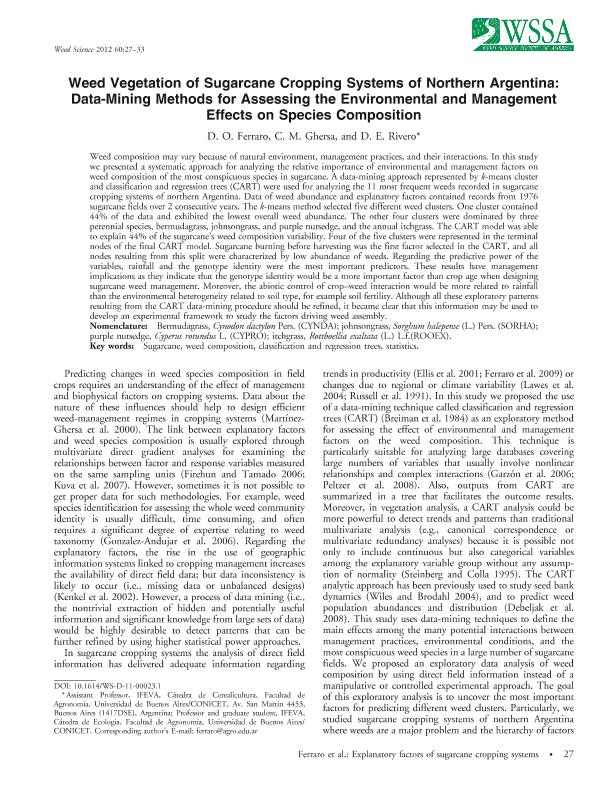Artículo
Weed vegetation of sugarcane cropping systems of northern argentina: Data-mining methods for assessing the environmental and management effects on species composition
Fecha de publicación:
01/2012
Editorial:
Weed Science Society of America
Revista:
Weed Science
ISSN:
0043-1745
Idioma:
Inglés
Tipo de recurso:
Artículo publicado
Clasificación temática:
Resumen
Weed composition may vary because of natural environment, management practices, and their interactions. In this study we presented a systematic approach for analyzing the relative importance of environmental and management factors on weed composition of the most conspicuous species in sugarcane. A data-mining approach represented by k-means cluster and classification and regression trees (CART) were used for analyzing the 11 most frequent weeds recorded in sugarcane cropping systems of northern Argentina. Data of weed abundance and explanatory factors contained records from 1976 sugarcane fields over 2 consecutive years. The k-means method selected five different weed clusters. One cluster contained 44% of the data and exhibited the lowest overall weed abundance. The other four clusters were dominated by three perennial species, bermudagrass, johnsongrass, and purple nutsedge, and the annual itchgrass. The CART model was able to explain 44% of the sugarcane's weed composition variability. Four of the five clusters were represented in the terminal nodes of the final CART model. Sugarcane burning before harvesting was the first factor selected in the CART, and all nodes resulting from this split were characterized by low abundance of weeds. Regarding the predictive power of the variables, rainfall and the genotype identity were the most important predictors. These results have management implications as they indicate that the genotype identity would be a more important factor than crop age when designing sugarcane weed management. Moreover, the abiotic control of cropweed interaction would be more related to rainfall than the environmental heterogeneity related to soil type, for example soil fertility. Although all these exploratory patterns resulting from the CART data-mining procedure should be refined, it became clear that this information may be used to develop an experimental framework to study the factors driving weed assembly. Nomenclature: Bermudagrass, Cynodon dactylon Pers. (CYNDA); johnsongrass, Sorghum halepense (L.) Pers. (SORHA); purple nutsedge, Cyperus rotundus L. (CYPRO); itchgrass, Rottboellia exaltata (L.) L.f.(ROOEX). © Weed Science Society of America.
Palabras clave:
Classification And Regression Trees
,
Statistics
,
Sugarcane
,
Weed Composition
Archivos asociados
Licencia
Identificadores
Colecciones
Articulos(IFEVA)
Articulos de INST.D/INV.FISIOLOGICAS Y ECO.VINCULADAS A L/AGRIC
Articulos de INST.D/INV.FISIOLOGICAS Y ECO.VINCULADAS A L/AGRIC
Citación
Ferraro, Diego Omar; Ghersa, Claudio Marco; Rivero, Diego Eduardo; Weed vegetation of sugarcane cropping systems of northern argentina: Data-mining methods for assessing the environmental and management effects on species composition; Weed Science Society of America; Weed Science; 60; 1; 1-2012; 27-33
Compartir
Altmétricas




